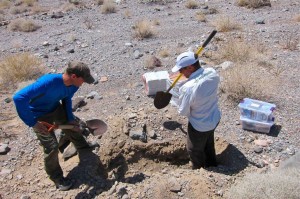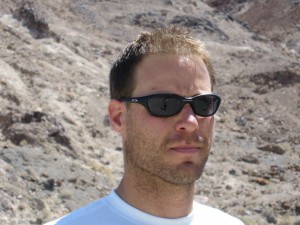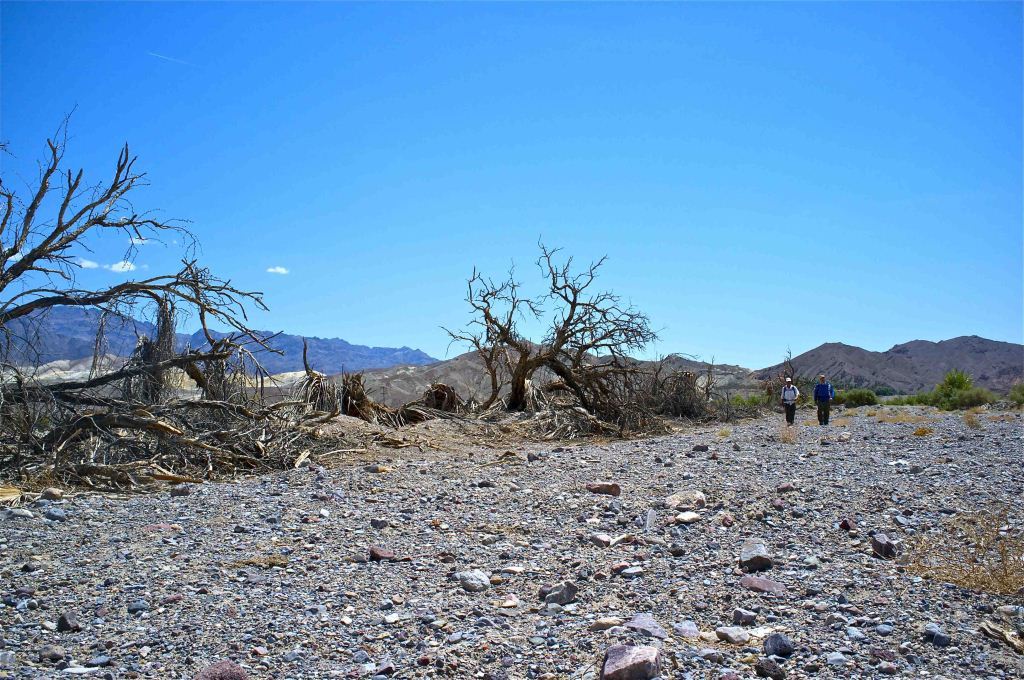
Photo courtesy Rick Barraff.
Ever wonder what it would be like to pound sand 16 hours a day in 100-degree weather? Me neither, but now I know.
Dave Heckman and I just returned from stashing our food, water, and supplies for our July circumnavigation of Death Valley National Park. He swung the pick, and I wielded the shovel, and together we dug about one hole an hour, 38 holes in all. [Please note: we didn’t dig in the national park, which is prohibited. Our stashes were placed along our route, just outside the perimeter of the park.]
We met five years ago at a training camp I was running in Death Valley, and Dave impressed me as guy who doesn’t take himself too seriously and lives on a pretty even keel, without a lot of highs and lows. In time, I also got to see how damn funny he can be.
I’m thinking his dry sense of humor should come in handy out in the desert. Ba-dump-bump.

Dave Heckman
Neither of us are clock-watchers, and we were in sync when we were digging, especially about just getting the job done no matter how long it took. I’m looking forward to getting this expedition underway with him and appreciate the expertise he brings: as a fire fighter and medic who’s worked at the Badwater Ultramarathon for several years, there’s a degree of calm under pressure that’s invaluable. (BTW, we leave for the circumnavigation just a couple of days after Badwater, where I’ll make my attempt at a 24th crossing, wearing bib #24.) He’s also an athlete, of course, especially into endurance running and cycling. One of his favorite activities is camping in Death Valley National Park, and he’s spent many days there and in the surrounding desert. Plus, plus, plus.
Dave’s also a family man, happily married to his wife Vanessa, and from what I’ve seen, Dave’s a great dad. After finishing our big dig and returning to Dave’s home in Northern California, we took his two young ones, Dylan (a few months) and Jack (3 years), on a long walk around Half Moon Bay, and I loved watching him interact with these little guys! So positive and encouraging, never a cross word, and it was obvious Jack had picked up on all that and helped to entertain Dylan, making him laugh as they rode side-by-side in a stroller for well over an hour.
Holes
Most of our stashes are 8 to 12 miles apart, although in the China Lakes area, it’s much farther than that. They’re all around 2 feet deep, nearly half are 2 feet by 18 inches, and the rest are trenches about the size of a short person’s grave. (We probably looked highly suspicious to passers-by. What passers-by? I’m sure those kangaroo rats and scorpions would have raised their eyebrows at us if they’d had eyebrows.) The bigger holes hold our caches for our overnight stays, while the smaller ones have just the water we need on the move. We had to make two caches in rock piles, because there wasn’t any suitable place to dig down.
In all, we buried 350 gallons of water and expect to drink about 2/3 of it. In the southern parts of our route, where temps will be over 120 degrees, we’ll need a gallon an hour to stay properly hydrated. We also put in a bunch of freeze-dried meals our sponsor RacingThePlanet gave us: Expedition Foods, including a bunch “formulated for Asian tastes,” which means we’ll get to enjoy some traditional Chinese flavors along with our Dinty Moore stew. To protect the stashes from critters, we spread some cayenne pepper in and around each hole.
Meanwhile, folks on Facebook have been asking a few questions about how this is going to work:
How will you know where you’ve buried your stuff?
The sites are unmarked, but we noted GPS coordinates and took photos of the surroundings, as well as stepped off and recorded the distance from some significant landmark, like an identifiable rock.
How will you keep the water cool?
That’s one of the benefits of burying the water. It should be 40 to 50 degrees cooler than the air temperature.
What will you do with trash?
We’re bagging up anything unused or left over from each cache and leaving it at a designated spot for Heather and some helpers to pick up after us. We intend to follow the credo of “leave no trace,” making sure that we leave each place as we found it or better.
Will there be a book or a film about this expedition?
We’re hoping a major magazine will cover it, and we’re laying the groundwork to produce a documentary or TV special. More than that, we do want to share the history of the Valley’s people and events, starting with the Timbisha Shoshone and including the explorers, miners, and visionaries. We’d love to convey the magic, mystery, and variety of landscapes in Death Valley National Park — this is not an empty, ugly place but rather one of the most miraculous and beautiful.
Do you have any questions about the expedition? I’m happy to answer them here.












Very cool! So excited for your adventure!
Tammy Nickerson´s last blog post ..Welcome to Walk Across Ohio!
Thanks Tammy, looked on your website and am impressed with the change of lifestyle you have had. Best of luck!
Nice! sounds like a adventure. I camped in death valley with friends for a week, it was in February so it wasn’t to hot, its actually really beautiful in some places
This post made me think of the movie Holes with Shia LaBeouf. It’s a great movie!
marshall, i’m so excited to see the newsletter from your journey….i am hoping , that i could be one of your adventure….i started running 9yrs ago, and became so passionate of running everyday…..this october 27, 2012 , ill be doing a solo run at new jersey 50 miles to raise money for sierra leonne in africa, to build a house…….goodluck on your journey………rainier layug n.j.
Good luck on this amazing adventure! The aid drops in holes is a great idea for some of the longer trail runs I was thinking of, and the cayenne, too.